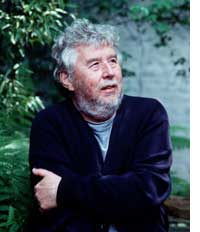Harrison Birtwistle: The Minotaur premiere at Covent Garden

Birtwistle: The Minotaur premiere at Covent Garden
Harrison Birtwistle’s new opera, The Minotaur, receives its world premiere at the Royal Opera House, Covent Garden in London on 15 April. John Tomlinson, in the title role, leads a cast including Christine Rice (Ariadne), Johnan Reuter (Theseus), Philip Langridge (Heirus) and Andrew Watts (Snake Priestess). The work is commissioned by The Royal Opera and its Music Director Antonio Pappano conducts the premiere in a production by Stephen Langridge with designs by Alison Chitty.
The libretto for The Minotaur is by the poet David Harsent, who has collaborated with Birtwistle on earlier works including Gawain, also premiered by The Royal Opera. Harsent’s retelling of the myth considers the inner world of the Minotaur himself, imprisoned in the labyrinth and inhabiting a narrow, pitiless world.
View a video podcast of David Harsent introducing the opera.
The Minotaur does not fully comprehend the duality of his physical nature as half-bull, half-man; only in sleep and, ultimately, in death does his human side become evident. Ariadne hopes that, with the help of the Oracle, she will enable Theseus to find a way out of the labyrinth should he survive his encounter with the Minotaur. She believes she can persuade Theseus to take her back with him to Athens. Both see the Minotaur as scapegoat and deliverance.
In a recent interview Birtwistle described his vision for the opera: “The starting point was the image of a beach, with Ariadne walking ‘this shoreline like a flightless bird’ when she sees the sails of Theseus’s ship and a means of escape. But beyond that the stage is really an open psychological space for the director. Even when the ‘Innocents’ enter the maze, Ariadne and the chorus are somehow present too, observing and participating in the ritual sacrifice. “Imagining John Tomlinson on stage in the lead role was integral to the whole project and I fully intended it to be a vehicle for him. I’ve heard him sing in Punch and Judy and Gawain and I modelled the vocal range on that of Hagen, one of his greatest Wagner roles.”
To read the full Birtwistle interview visit our Opera website.
Boosey & Hawkes is publishing David Harsent’s libretto for The Minotaur, which will be available from 25 March in all good music shops including the Royal Opera House shop and
www.boosey.com/shop.
For tickets for the opera visit www.roh.org.uk
Synopsis
by David Harsent
The Minotaur was the mythical beast, half-man, half-bull, imprisoned in the Labyrinth on the island of Crete. He was the offspring of Pasiphae, wife to King Minos: the result of her unnatural lust for the bull from the sea – sent by the god Poseidon at the request of Minos.
Athens is required each year to send young men and women for sacrifice to the Minotaur. This is an act of revenge for the death of Minos’s son at the hands of the Athenians. Theseus, putative son of Aegeus, king of Athens (though perhaps the son of Poseidon) offers to go to Crete on the occasion of one such sacrifice. His intention is to slay the Minotaur and thus cancel the debt.
At the start of the opera Ariadne, daughter of Minos and Pasiphae, greets the Innocents as they arrive from Athens. Among them is Theseus. She is attracted to him, but they are suspicious of each other’s motives. Ariadne is desperate to escape the prison of the island – the prison of her legacy – and sees in Theseus the possibility of escape.
In his dreams, the Minotaur – otherwise inarticulate – expresses the human side of his dual personality. In two symmetrical scenes, one in each half of the opera, he has visions of Ariadne, of his double, and of a shadowy figure (it is Theseus) who poses a threat to him, though he cannot understand what this is.
In a bloodthirsty but ritualised scene at the centre of the work, the sacrificial victims are caught and gored by the Minotaur. Keres, female death-spirits in the form of harpies, tear the hearts from the neardead and feed on the bloody carcasses.
Ariadne attempts to persuade Theseus to take her with him back to Athens, but he refuses. She consults the Oracle in the hope of finding a way to ensure that, if Theseus is successful in his fight with the Minotaur, he will be able to find his way back out of the Labyrinth. She believes that, by acquiring this knowledge, she will achieve the kind of bargaining power to force him to do what she wants. The Oracle, speaking through the medium of a priest, or Hiereus, tells Ariadne to give Theseus a ball of twine that he can unwind as he goes through the Labyrinth and then follow back to safety. In answer to her insistent question, the Oracle also confirms to Ariadne that she and Theseus will set sail for Athens together, though this prophecy, while accurate, hints at Ariadne’s downfall.
The final section of the opera concerns the fight between Theseus and the Minotaur, and the latter’s death. As his life ebbs, the Minotaur acquires the power of human language: he describes the emptiness of his existence. As Ariadne and Theseus sail away, the Keres return and feed upon the body of the Minotaur, mirroring the end of the first half of the drama.
© David Harsent, 2008
The Minotaur (2005-07 )
(world premiere)
Opera in 13 scenes
Libretto by David Harsent
Commissioned by The Royal Opera
Antonio Pappano Conductor
Stephen Langridge Director
Alison Chitty Designer
The Minotaur: John Tomlinson
Ariadne: Christine Rice
Theseus: Johan Reuter
Snake Priestess: Andrew Watts
Royal Opera, Covent Garden
15/19/21/25/30 April, 3 May 2008
The Royal Opera, Covent Garden, London
www.roh.org.uk
Read this press release as a PDF Download
> Further information on Work: The Minotaur
Photo: Hanya Chlala/ArenaPAL
